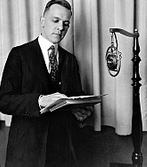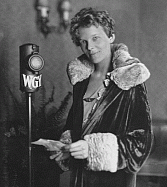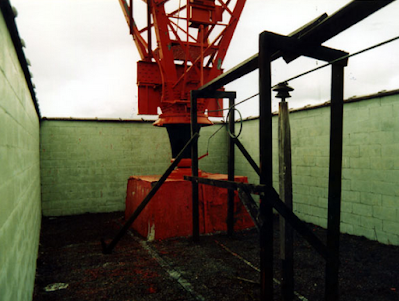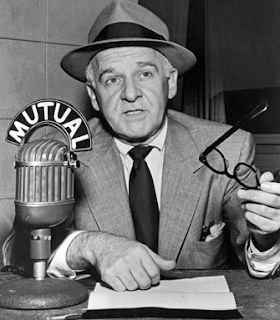➦In 1906..Radio/TV Actor Gale Gordon was born.
(Real Name Charles Thomas Aldrich, Jr., died from lung cancer June 30, 1995) is best remembered as Lucille Ball's longtime television foil—and particularly as cantankerously combustible, tightfisted bank executive Theodore J. Mooney, on Ball's second television situation comedy.
 |
| Gale Gordon |
Gordon and his character of Mayor La Trivia briefly left the show in December 1942 when Gordon enlisted in World War II and the storyline followed. He was the first actor to play the role of Flash Gordon, in the 1935 radio serial The Amazing Interplanetary Adventures of Flash Gordon. He also played Dr. Stevens in Glorious One.
In 1950, Gordon played John Granby in the radio series Granby's Green Acres, which became the basis for the 1960s television series Green Acres. Gordon went on to create the role of pompous principal Osgood Conklin on Our Miss Brooks, carrying the role to television when the show moved there in 1952. In the interim, Gordon turned up as Rudolph Atterbury on My Favorite Husband, which starred Lucille Ball in a precursor to I Love Lucy.
 |
| Jim Jewell |
Jewell first got into radio in 1927. with a background of summer stock, vaudeville, burlesque, and even touring with a troupe of marionettes. In June 1932, George Trendle, the owner of radio station WXYZ Detroit, decided to drop network affiliation and produce his own radio programs. Jewell was hired as the dramatic director for the radio station. He supplied the actors from his own repertory company, the "Jewell Players".
Jewell was part of the station staff that worked out the original concepts for The Lone Ranger. Jewell is also credited for selecting The William Tell Overture as the theme music for the series. "Ke-mo sah-bee", Tonto's greeting to the masked Ranger, was derived from the name of a boys' camp owned by Jewell's father-in-law Charles W. Yeager. Camp Kee-Mo-Sah-Bee operated from 1911 until 1941 on Mullet Lake south of Mackinac, Michigan. After the radio show became popular, Yeager held "Lone Ranger Camps" at his camp.Jewell produced, directed and occasionally wrote many of the early episodes for The Lone Ranger and The Green Hornet. He was the director for both series from their beginning up until 1938.
Jewell left WXYZ in 1938, and moved to Chicago and worked as a director-producer at WBBM (AM), the CBS radio affiliate in Chicago.
He directed Jack Armstrong, the All-American Boy beginning in 1938 until the series ended in 1951. From 1951-1955, Jewell was the producer/director of The Silver Eagle, a mountie adventure which ran on ABC and starred Jim Ameche, the brother of movie star Don Ameche.
As the era of radio dramatic series came to an end, attempted to bring The Silver Eagle to television.
➦In 1914...John Charles Patrick Croghan Daly was born (Died February 24, 1991). Known as John Daly, he was a radio and television personality, CBS News broadcast journalist, ABC News executive and TV anchor and a game show host, best known as the host and moderator of the CBS television panel show What's My Line?
Daly began his broadcasting career as a reporter for NBC Radio, and then for WJSV (now WTOP), the local CBS Radio Network affiliate in Washington, D.C., serving as CBS' White House correspondent. He appears on the famous "One Day in Radio" tapes of September 21, 1939, in which WJSV preserved its entire broadcast day for posterity.
Through covering the Roosevelt White House, Daly became known to the national CBS audience as the network announcer for many of the President's speeches. In late 1941, Daly transferred to New York City, where he became anchor of The World Today. During World War II, he covered the news from London as well as the North African and Italian fronts. Daly was a war correspondent in 1943 in Italy during Gen. George S. Patton's infamous "slapping incidents". After the war, he was a lead reporter on CBS Radio's news/entertainment program CBS Is There (later known on TV as You Are There), which recreated the great events of history as if CBS correspondents were on the scene.
As a reporter for the CBS radio network, Daly was the voice of two historic announcements. He was the first national correspondent to deliver the news of the attack on Pearl Harbor on Sunday, December 7, 1941, and he was also the first to relay the wire service report of the death of President Franklin D. Roosevelt on April 12, 1945, interrupting the program Wilderness Road to deliver the news. Transcriptions of those bulletins have been preserved on historical record album retrospectives and radio and television documentaries. Among the first were the Columbia Records spoken word series I Can Hear It Now and the later CBS Television series, The Twentieth Century.
In July, 1959, along with the Associated Press writer John Scali, he reported from Moscow on the famous Kitchen Debate between USSR General Secretary Nikita Khrushchev and then U.S. Vice President Richard M. Nixon in 1959.
➦In 1922...WGY-AM, Schenectady, NY signed-on. As early as 1912, General Electric company in Schenectady began experimenting with radio transmissions, being granted a class 2-Experimental license for 2XI on August 13, 1912 by the Commerce Department.
WGY signed on on February 20, 1922 at 7:47pm at 360 meters wavelength (about 833 kHz), with Kolin Hager at the mike, or as he was known on the air, as KH. Hager signed on with the stations call letters, explaining the W is for wireless, G for General Electric, and Y, the last letter in Schenectady.
The first broadcast lasted for about one hour and consisted of live music and announcements of song titles and other information. The early broadcasts originated from building 36 at the General Electric Plant in Schenectady. The original transmitter produced an antenna power of 1,500 watts into a T top wire antenna, located about 1/2 mile away, also at the GE plant.
WGY led the way in radio drama. In 1922 Edward H. Smith, director of a community-theater group called the Masque in nearby Troy, suggested weekly forty-minute adaptations of plays to WGY station manager Kolin Hager. Hager took him up on it and the troupe performed on the weekly WGY Players, radio’s first dramatic series.
 |
| Kolin Hager |
By May 15, 1923 the station was operating on 790 kHz with a frequency/time share agreement with RPI's WHAZ. Later, WHAZ moved to 1300 kHz allowing WGY to operate full-time on 790 kHz.
In 1924, the transmitter site was moved to its current location in the Town of Rotterdam known as South Schenectady. From this site, the station's power levels were increased first to 5,000 watts, then 10,000 watts and finally to 50,000 watts on July 18, 1925. Temporary broadcasts were carried out at the 100 KW (August 4, 1926) and 200 KW (March 9, 1930) power levels. From those broadcasts, the station received reception letters and telegrams from as far away as New Zealand. Plans were to make those power increases permanent, but were never carried out.
 |
| Amelia Earhart |
In 1923, WGY formed the first radio network with WJZ and WRC, however the station also broadcast programs from rival station WEAF. Later in 1925, the New York State radio network was formed with WMAK, WHAM, WFBL, and WGY. In 1926, WGY affiliated with the WEAF-based NBC Red Network, and after the split of the sister NBC Blue network into today's ABC Radio, WGY remained with NBC Radio until it folded in 1989.
To add to their laurels, six years later the Players performed an old spy melodrama titled The Queen’s Messenger in the world’s first dramatic program to be broadcast simultaneously over both radio and the new medium called television.
“Radio station WGY had cornered the market on talk and music by 1928,” the Daily Gazette recalled. “Scientists from the General Electric Co. could have winked to their audience and said, ‘You ain't seen nothing yet.’ The smart guys who developed amplifiers, transmitters and bright lights were working on that next step—sound and pictures. On Tuesday, Sept. 11, 1928, they succeeded. WGY became the first radio station in the world to televise a drama on separate radio channels.”
 |
| WGY Tower Base |
In 1941, WGY changed frequency from 790 kHz to 810 kHz to comply with the North American Radio Broadcasting Agreement also known as NARBA. In 1942, during World War II, a concrete wall was built around the base of the tower to prevent saboteurs from shooting out the base insulator on the tower and taking the station off-air.
WGY was the flagship station of General Electric's broadcasting group until 1983 when it was sold to Empire Radio Partners, Inc. General Electric also owned pioneering sister stations in television (WRGB-TV, signed on as WGY-TV in 1928) and FM radio (W2XOY, later WGFM, then WGY-FM, and today WRVE, signed on 1940).
As the golden age of radio ended, WGY evolved into a full service middle of the road format, slowly evolving as programming tastes changed. The station changed from full service to news/talk on Memorial Day Weekend, 1994.Dame Media, Inc acquired WGY and WGY-FM the during proceedings in the Philadelphia bankruptcy court, late 1993. Dame moved the studios to One Washington Square at the end of Washington Avenue Extension, in the west end of Albany, New York late 1994, where they remained until 2005.
In 1999, Dame Media sold its entire radio group to Clear Channel (now iHeartMedia), whose ownership remains to this day. Clear Channel combined all of its radio station studio operations into the former CHP (Community Health Plan) building on Route 7 (Troy-Schenectady Road) in Latham August, 2005.
On September 20, 2010, WGY began simulcasting its programming on 103.1 FM (the former WHRL, which took the calls WGY-FM, previously on 99.5 FM). WGY 103.1 FM broadcasts at 5,600 watts power.
➦In 1949...future teen singing idol, 8-year old Ricky Nelson, and his older brother David began playing themselves on their parents’ radio show, “The Adventures of Ozzie & Harriet.” Until now Ricky had been played by child actor Henry Blair, while David was played by Tommy Bernard.
In 1952, the Nelsons tested the waters for a television series with the theatrically released film Here Come the Nelsons. The film was a hit, and Ozzie was convinced the family could make the transition from radio's airwaves to television's small screen. On October 3, 1952, The Adventures of Ozzie and Harriet made its television debut and was broadcast in first run until September 3, 1966, to become one of the longest-running sitcoms in television history.
➦In 1971...NORAD at Cheyenne Mountain in Colorado was ready to broadcast a required weekly test of the Emergency Broadcast System.
However, AT&T reported that the United States Air Force accidentally used the wrong tape for the test, and initiated an Emergency Action Notification, normally issued by the Office of Civil Defense or the President. This prompted all stations in the Fort Wayne, Indiana, area by order of the FCC to operate under emergency procedures and feed the broadcast from WOWO through their radios.
Bob Sievers was at the microphone at WOWO at the time. Sievers and everyone at the studio had no idea what was going on.
Mistake wasn't resolved for 30 minutes.
 |
| Walter Winchell |
 |
| Rosemary DeCamp |
➦In 2001...Radio, TV, Film Actress actress Rosemary De Camp succumbed to pneumonia at age 90. She shined in many roles on bigtime radio, including the long running part of nurse Judy Price on CBS’ Dr. Christian. On TV she was Peg Riley on Life of Riley, and also had feature roles on The Bob Cummings Show & That Girl.
➦In 2003...99 people were killed when fire destroyed the nightclub The Station in West Warwick RI. The fire started with sparks from a pyrotechnic display being used by the band Great White. Among those who died in the fire were Great White's lead guitarist, Ty Longley, and the show's emcee, WHJY 94.1 FM Providence personality Mike "The Doctor" Gonsalves.
➦In 2006...Sportscaster Curtis Edward Gowdy (Born July 31, 1919) died of leukemia at age 86 in Palm Beach, Fla., at age 86, after a long battle with leukemia. He’d been part of the national broadcast of 13 World Series, 16 baseball All-Star Games, 9 Super Bowls, 14 Rose Bowls, 8 Olympic Games and 24 NCAA Final Fours. He also hosted ABC-TV’s long-running outdoors show The American Sportsman. He was well known as the longtime "voice" of the Boston Red Sox and for his coverage of many nationally televised sporting events, primarily for NBC Sports and ABC Sports in the 1960s and 1970s.
He had a knack for broadcasting, and, in 1942, worked at the small KFBC radio station and at the Cheyenne, Wyoming Eagle newspaper as a sportswriter (and later sports editor). After several years in Cheyenne, he accepted an offer from CBS's KOMA radio in Oklahoma City in 1946. He was hired primarily to broadcast Oklahoma college football (then coached by new-hire Bud Wilkinson) and Oklahoma State college basketball games (then coached by Hank Iba).
 |
| Curt Gowdy |
In April 1951 at the age of 31, Gowdy began his tenure as the lead announcer for the Red Sox. For the next 15 years, he called the exploits of generally mediocre Red Sox teams on WHDH radio and on three Boston TV stations: WBZ-TV, WHDH-TV, and WNAC-TV (WBZ and WNAC split the Red Sox TV schedule from 1948 through 1955; WBZ alone carried the Red Sox from 1955 through 1957; and WHDH took over in 1958). During that time, Gowdy partnered with two future baseball broadcasting legends: Bob Murphy and Ned Martin. Chronic back pain caused Gowdy to miss the entire 1957 season. He also did nightly sports reports on WHDH radio when his schedule permitted.
He left WHDH after the 1965 season for NBC Sports, where for the next ten years he called the national baseball telecasts of the Saturday afternoon Game of the Week and Monday Night Baseball during the regular season (and the All-Star Game in July), and the postseason playoffs and World Series in October.
 |
| Danny Holiday |
He spent decades spinning top-40 hits and oldies on Seattle stations KOL, KZOK and KBSG. In retirement, he brought his Rock ‘N’ Roll Time Machine to community radio, hosting the weekly show on Everett’s KSER (90.7 FM).
Holiday was inducted into NorthWest Music Hall of Fame in 1990.
In 2014…Former NBC News correspondent Garrick Utley died at age 74. His parents, Frayn and Clifton Utley, were correspondents for NBC radio in the mid-20th century, based in Chicago. When he passed he professor of broadcasting and journalism at the State University of New York at Oswego, NY.
 |
| Buffy Sainte-Marie is 83 |
- Singer-songwriter Buffy Sainte-Marie is 83.
- Actor Brenda Blethyn (“Atonement,” ″Pride and Prejudice”) is 78.
- Actor Sandy Duncan is 78.
- Actor Peter Strauss is 77.
- Guitarist Billy Zoom of X is 76.
- Country singer Kathie Baillie of Baillie and the Boys is 73.
- Actor John Voldstad (“Newhart”) is 73.
- Actor Anthony Head (“Buffy The Vampire Slayer”) is 70.
- Actor James Wilby (“Gosford Park”) is 66.
- Bassist Sebastian Steinberg (Soul Coughing) is 65.
- Actor Joel Hodgson (“Mystery Science Theater 3000″) is 64.
- Singer Ian Brown of Stone Roses is 61.
- Actor French Stewart (“Mom,” “Third Rock from the Sun”) is 60.
- Model Cindy Crawford is 58.
- Actor Andrew Shue (“Melrose Place”) is 57.
- Actor Lili Taylor is 57.
- Singer Brian Littrell of the Backstreet Boys is 49.
- Actor Lauren Ambrose (“Six Feet Under”) is 46.
- Actor Jay Hernandez (“Friday Night Lights,” ″Crazy/Beautiful”) is 46.
- Actor Chelsea Peretti (“Brooklyn Nine-Nine”) is 46.
- Guitarist Coy Bowles of Zac Brown Band is 45.
- Actor Michael Zegen (“The Marvelous Mrs. Maisel,” ″Boardwalk Empire”) is 45.
- Actor Majandra Delfino (“Roswell”) is 43.
- Actor Jocko Sims (“New Amsterdam”) is 43.
- Musician and “A Prairie Home Companion” host Chris Thile (Punch Brothers, Nickel Creek) is 43.
- Actor-singer Jessie Mueller is 41.
- Comedian Trevor Noah (“The Daily Show”) is 40.
- Actor Miles Teller (“Top Gun: Maverick,” “Fantastic Four”) is 37.
- Singer Rihanna is 36.
- Actor Jack Falahee (“How to Get Away With Murder”) is 35.
- In 1972..Walter Winchell, American journalist, gossip columnist, radio host, and narrator (the Untouchables), dies at 74
- In 2004..J. J. Malone, Soul singer ("It's A Shame"), dies of cancer at 68
- In 2022..Joni James [Joan Babbo], Pop singer ("Why Don't You Believe Me?"; "How Important Can It Be?"), dies at 91




No comments:
Post a Comment
Note: Only a member of this blog may post a comment.